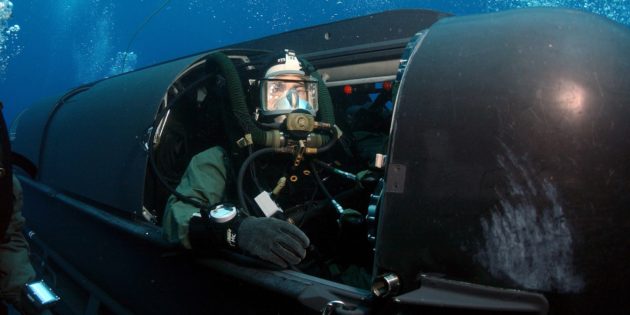Late in August, the Navy SEAL Teams went through a significant restructuring, with two units being disestablished and consolidated into a new one.
Naval Special Warfare Group 3 and Naval Special Warfare Group 10 were deactivated and their “headquarters, missions, functions, and tasks” combined in the new Naval Special Warfare Group 8.
The creation of NSWG 8 is yet another sign of Naval Special Warfare’s pivot to great-power competition with near-peer states, namely China and Russia.
As US Special Operations Command’s dedicated maritime special-operations force, Naval Special Warfare would play a significant role in that competition or a future conflict.
America’s dedicated maritime commandos
Naval Special Warfare Command comprises the Navy SEALs and Special Warfare Combatant-Craft Crewmen (SWCC). There are about 8,000 personnel assigned to Naval Special Warfare Command, but less than 3,000 of them are special operators — SEALs and SWCCs. The rest are military and civilian support personnel.
NSWG 3 contained the SEAL Delivery Vehicle (SDV) Teams, a capability unique to the Navy SEALs. Equipped with mini-submarines, SDV Teams specialize in underwater insertion and extraction of special-operations troops, underwater special operations, and special reconnaissance.
I was fired from Google after my productivity plummeted
NSWG 10 was established in 2011 to give the SEAL Teams an organic intelligence-gathering and low-visibility capability. It included the Special Reconnaissance Teams and other units specializing in cyberwarfare; electronic warfare; and intelligence, surveillance, and reconnaissance.
The global war on terror showcased the need for dedicated intelligence-gathering units that could funnel actionable intelligence and targets to SEAL platoons.
In addition, the Special Reconnaissance Teams offered Naval Special Warfare Command an organic capability to conduct operational preparation of the environment or battlefield.
For these low-visibility operations, small teams of special operators deploy to hotspots worldwide to take “atmospherics” and prepare for the deployment of larger follow-on forces.
“This realignment within NSW integrates distinctive capabilities to create new irregular options to help solve the hardest national security problems, undermine the confidence of our adversaries, and contribute to integrated [sic] all domain deterrence,” Rear Adm. H.W. Howard III, commander of Naval Special Warfare Command, said during the consolidation ceremony.
Now the Naval Special Warfare Command seeks to bring the two capabilities closer and combine command and control for benefit of both.
Workers ‘ghosting coasting’ is latest challenge for employers
The consolidation is part of Naval Special Warfare’s transformation from a force mainly focused on counterterrorism and counterinsurgency to one geared toward great-power competition, which can include anything from proxy warfare to open conflict.
But the fact that the former commanding officer of NSWG 3 was selected to lead the new unit over his NSWG 10 counterpart suggests that the SDVs will have an important role going forward.
SEAL Delivery Vehicles: a unique capability
First established in the 1980s, the SEAL Delivery Vehicle Teams brought a unique capability to the US military’s arsenal.
The SDVs were designed to operate clandestinely close to enemy coasts and inside harbors and anchorages. They can be deployed by land, in the water from a vessel or submarine, or by air from a helicopter.
The SDVs are a great option, as they can support or carry out intelligence-gathering or direct-action operations anywhere in the world.
When it comes to intelligence-gathering, SDVs can approach unfriendly coasts either to drop small teams of SEALs or place sensors at places of interest — such as sensitive areas in the South China Sea, Black Sea, or Baltic Sea.
For decades, the workhorse of the SDVs was the Mark 8 SEAL Delivery Vehicle, a mini-submarine that could stealthily carry several SEAL operators and all their gear close to a target over long distances.
Another SDV, the Mark 9, which is now decommissioned, was outfitted with munitions and could sink enemy vessels at anchor or place limpet mines on enemy hulls.
A new generation of SDVs is now joining the fleet and taking the lead in underwater special operations. The Mark 11 Shallow Water Combat Submersible, Dry Combat Submersible, and a number of unmanned undersea vehicles are either in development, undergoing final operations trials, or in use.
“The SDV teams are a great booster for NSW, though many [in the community] chose to ignore that, or at least that was the mentality when the wars still demanded [SEAL] platoons,” a former Navy SEAL operator told Insider. “Unless you like the element and mission, [the SDVs] suck. Spending eight or more hours diving isn’t the idea of fun for many SEALs, lots of whom don’t really like the water.”
“But in the SDV teams you get to do some unique stuff that you won’t find elsewhere in the military and only in a very few other places in the world. SDVs don’t see action often, but their missions, whether it’s training or not, are unique,” said the former SEAL operator, who served in an SDV Team.
Stavros Atlamazoglou is a defense journalist specializing in special operations, a Hellenic Army veteran (national service with the 575th Marine Battalion and Army HQ), and a Johns Hopkins University graduate.
https://www.businessinsider.com/new-naval-special-warfare-group-created-amid-great-power-competition-2021-9


Leave a Reply
You must be logged in to post a comment.